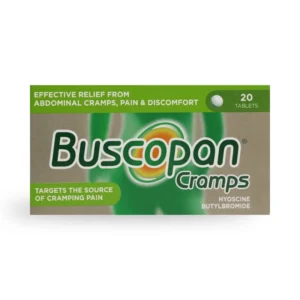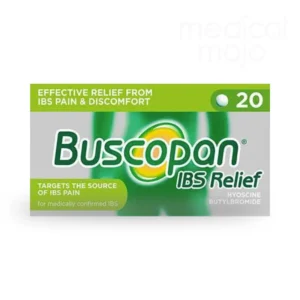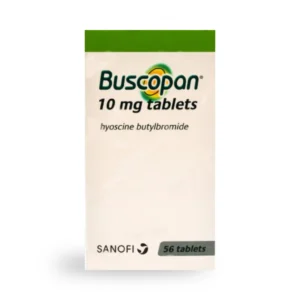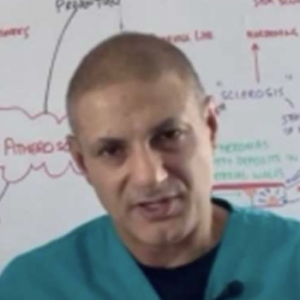Buscopan is a popular antispasmodic medication containing the active ingredient hyoscine butylbromide. So, what is Buscopan used for? Buscopan is used to relieve painful stomach cramps, including those associated with irritable bowel syndrome (IBS). It can also effectively relieve bladder cramps and menstrual pain (NHS., 2024).
In this article, we will not only cover what Buscopan is used for but also explain how Buscopan works, its side effects, and the best way to take it. You can use the handy navigational table below to jump quickly to the topics that interest you.
-
 Buscopan Cramps TabletsPrice range: £5.49 through £16.49
Buscopan Cramps TabletsPrice range: £5.49 through £16.49 -
 Buscopan IBS Relief TabletsPrice range: £5.49 through £16.49
Buscopan IBS Relief TabletsPrice range: £5.49 through £16.49 -
 Buscopan 10mg tablets (56)Price range: £9.99 through £19.98
Buscopan 10mg tablets (56)Price range: £9.99 through £19.98
What is Buscopan?
Buscopan is the go-to medicine for painful abdominal spasms. Its active ingredient is hyoscine butylbromide (HBB), a compound extracted from the Duboisia tree, which grows mainly in Australia
How does Buscopan work?
Hyoscine butylbromide (HBB), often known as Buscopan, is a compound designed to calm down muscle spasms and reduce discomfort. It works by blocking acetylcholine, a chemical that usually causes muscles in areas like your stomach and bladder to contract (Samuels LA, 2009).
By interfering with acetylcholine’s action at specific receptors, Buscopan helps relax smooth muscles in the gut, bladder, and other parts of the body where cramps can occur. This makes it an effective choice for treating painful spasms and easing digestive and bladder issues.
Why do we get abdominal spasms?
These cramping abdominal spasms occur when the muscles in your gut start to contract. But before we leave it at that, let’s explore this a bit further because it gives us an insight into how Buscopan works.
Two nervous systems are used in two very different circumstances in the body. They are the:
- Parasympathetic nervous system: Rest and digest
- Sympathetic nervous system: Fight and flight
The sympathetic and parasympathetic nervous system
The sympathetic and parasympathetic nervous systems are two parts of the autonomic nervous system that control different automatic functions in the body.
- The sympathetic nervous system, often called the “fight-or-flight” system, kicks in during stressful situations, preparing the body for action by increasing heart rate, dilating pupils, and boosting blood flow to muscles.
- The parasympathetic nervous system is called the “rest and digest” system. It helps the body relax and recover by slowing down the heart rate, promoting digestion, and conserving energy. Together, these systems balance your body’s response to stress and relaxation (McCorry, L.K., 2007).
Acetylcholine and the parasympathetic nervous system
In simple terms, the parasympathetic nervous system relies on a chemical called acetylcholine to send signals in the body. These signals pass through two types of receptors: muscarinic and nicotinic.
Acetylcholine receptors are named nicotinic and muscarinic based on the substances that activate them specifically. Here’s a breakdown:
- Nicotinic Receptors: Named after nicotine, which can bind to and activate these receptors. These receptors are found in the neuromuscular junctions (where nerves connect to muscles), the brain, and the autonomic ganglia (which relay signals in the autonomic nervous system). They respond quickly to acetylcholine, leading to immediate reactions like muscle contraction.
- Muscarinic Receptors: Named after muscarine, a compound isolated from certain mushrooms, which specifically activates these receptors. Muscarinic receptors are more common in the central nervous system, heart, smooth muscles, and glands. They trigger slower, longer-lasting responses when activated by acetylcholine and are involved in heart rate regulation, digestion, and glandular secretions.
So, nicotinic and muscarinic receptors represent two different pathways for acetylcholine in the body, leading to distinct effects depending on which receptor type is activated (Brown, D.A., 2019).
Abdominal spasms and parasympathetic nervous system
Here’s how it works: first, one nerve releases acetylcholine, which triggers nicotinic receptors in another nerve. This second nerve then releases more acetylcholine, which activates muscarinic receptors on a target organ, like your stomach or bladder.
When the parasympathetic nervous system activates this chain reaction, it helps control things like digestion. However, excessive or unregulated contractions in the gut can lead to painful spasms, cramping, and discomfort.
Buscopan works by blocking the actions of acetylcholine at the muscarinic receptor
Buscopan works by blocking acetylcholine at its muscarinic receptors in the smooth muscles of the gastrointestinal and urinary tracts. This prevents the parasympathetic nervous system from overstimulating these muscles, causing them to relax. So, by blocking the effects of acetylcholine on the gut muscles, Buscopan acts as an antispasmodic (Corsetti et al., 2023).
In summary, Buscopan helps manage symptoms by blocking the parasympathetic nervous system’s messages that would otherwise cause intense muscle contractions in the stomach and other areas, relieving spasms and cramping.
What is Buscopan used for?
- abdominal pain,
- cramping,
- bloating,
- diarrhoea or
- constipation.
How quickly does Buscopan work?
Buscopan can start to work within 15 minutes of taking your first dose. It’s a fast-acting medicine designed to offer quick relief, so you’ll start feeling better soon after taking it. However, doubling up on a dose won’t make it work faster and could cause issues, so stick to the recommended dose.
What are the side effects of Buscopan?
As with any medicine, Buscopan may cause side effects (BNF 2024). Some of the most common ones include:
- Dizziness or feeling uncoordinated
- Dry mouth
- Constipation or digestive issues
- Trouble urinating
- Unusual sweating
- Facial redness
- Skin rashes or itching
- Blurred vision
- Rapid heartbeat
- Low blood pressure
- Trouble breathing
If you notice any of these symptoms, contact your doctor right away. Remember that reactions can vary, and other options might suit you better if side effects are an issue.
How to take Buscopan
Buscopan tablets each contain 10 mg of Hyoscine butylbromide. When used to provide relief from:
Dose of Buscopan used for symptoms of stomach or urinary issues that involve muscle cramps or spasms
Adult: 20 mg 4 times a day. (two 10mg tablets) (BNF 2024).
The dose of Buscopan used for symptoms of irritable bowel syndrome
Adult: 10 mg 3 times daily; increased up to 20 mg 4 times daily if necessary (BNF 2024).
You can take Buscopan with or without food, but it’s important to follow the treatment plan recommended by your doctor. Don’t take Buscopan unless instructed, as stopping too soon could bring back symptoms.
If you miss a dose, take it as soon as possible—unless it’s close to your next dose. Avoid taking a double dose to make up for the missed one. Follow your doctor’s instructions for the best results, and avoid exceeding the prescribed dose, as this can lead to overdose symptoms like restlessness, confusion, or dizziness. If any of these symptoms occur, seek medical help immediately.
Where to buy Buscopan 10mg tablets
You can buy the prescription pack of 56 Buscopan 10mg tablets by completing the online health questionnaire. You can also purchase the over-the-counter packs of Buscopan.
Medical Mojo stocks the following prescription pack of Buscopan:
Buscopan 10mg tablets prescription pack -56 tablets from £9.99
Disclaimer: This article is for informational purposes only and does not replace professional medical advice.
References:
- https://www.nhs.uk/medicines/buscopan-hyoscine-butylbromide/#:~:text=Buscopan%20relieves%20painful%20stomach%20cramps,the%20active%20ingredient%20hyoscine%20butylbromide.
- Samuels, L.A., 2009. Pharmacotherapy update: Hyoscine butylbromide in the treatment of abdominal spasms. Clinical Medicine. Therapeutics, 1, pp.CMT-S1134.
- McCorry, L.K., 2007. Physiology of the autonomic nervous system. American journal of pharmaceutical education, 71(4).
- Brown, D.A., 2019. Acetylcholine and cholinergic receptors. Brain and neuroscience advances, 3, p.2398212818820506.
- Corsetti, M., Forestier, S. and Jiménez, M., 2023. Hyoscine butylbromide mode of action on bowel motility: From pharmacology to clinical practice. Neurogastroenterology & Motility, 35(4), p.e14451.
- https://bnf.nice.org.uk/drugs/hyoscine-butylbromide/#indications-and-dose


